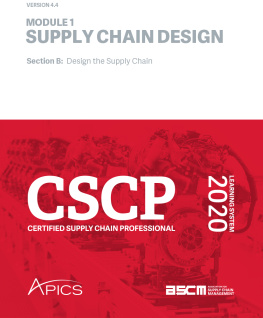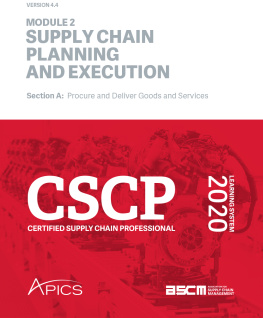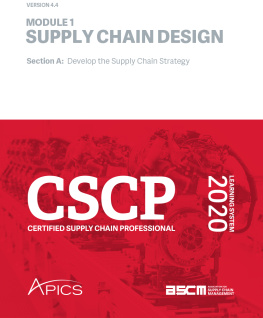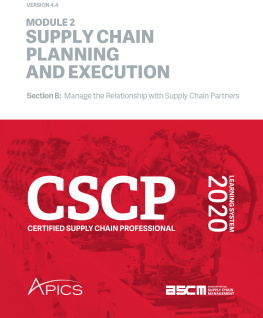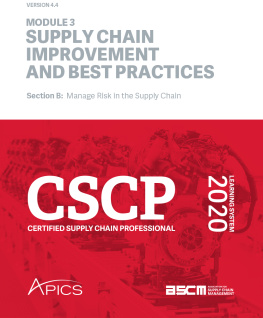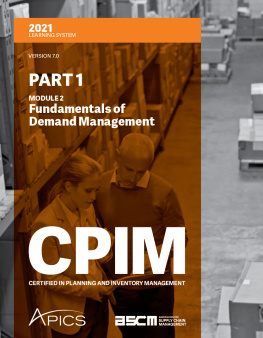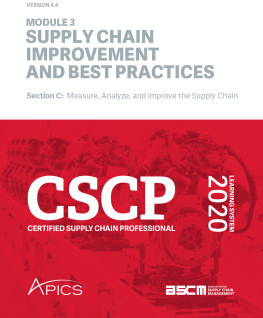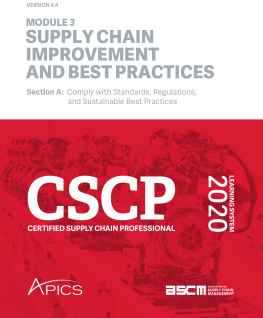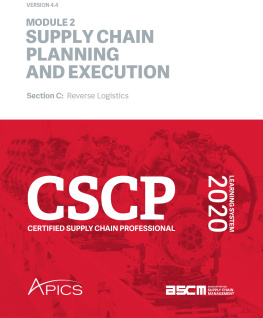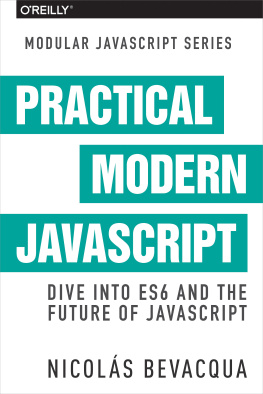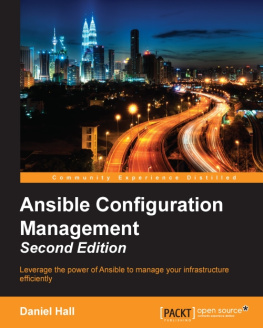APICS - CSCP 2020 Module 1 Section B
Here you can read online APICS - CSCP 2020 Module 1 Section B full text of the book (entire story) in english for free. Download pdf and epub, get meaning, cover and reviews about this ebook. genre: Business. Description of the work, (preface) as well as reviews are available. Best literature library LitArk.com created for fans of good reading and offers a wide selection of genres:
Romance novel
Science fiction
Adventure
Detective
Science
History
Home and family
Prose
Art
Politics
Computer
Non-fiction
Religion
Business
Children
Humor
Choose a favorite category and find really read worthwhile books. Enjoy immersion in the world of imagination, feel the emotions of the characters or learn something new for yourself, make an fascinating discovery.
- Book:CSCP 2020 Module 1 Section B
- Author:
- Genre:
- Rating:3 / 5
- Favourites:Add to favourites
- Your mark:
- 60
- 1
- 2
- 3
- 4
- 5
CSCP 2020 Module 1 Section B: summary, description and annotation
We offer to read an annotation, description, summary or preface (depends on what the author of the book "CSCP 2020 Module 1 Section B" wrote himself). If you haven't found the necessary information about the book — write in the comments, we will try to find it.
CSCP 2020 Module 1 Section B — read online for free the complete book (whole text) full work
Below is the text of the book, divided by pages. System saving the place of the last page read, allows you to conveniently read the book "CSCP 2020 Module 1 Section B" online for free, without having to search again every time where you left off. Put a bookmark, and you can go to the page where you finished reading at any time.
Font size:
Interval:
Bookmark:
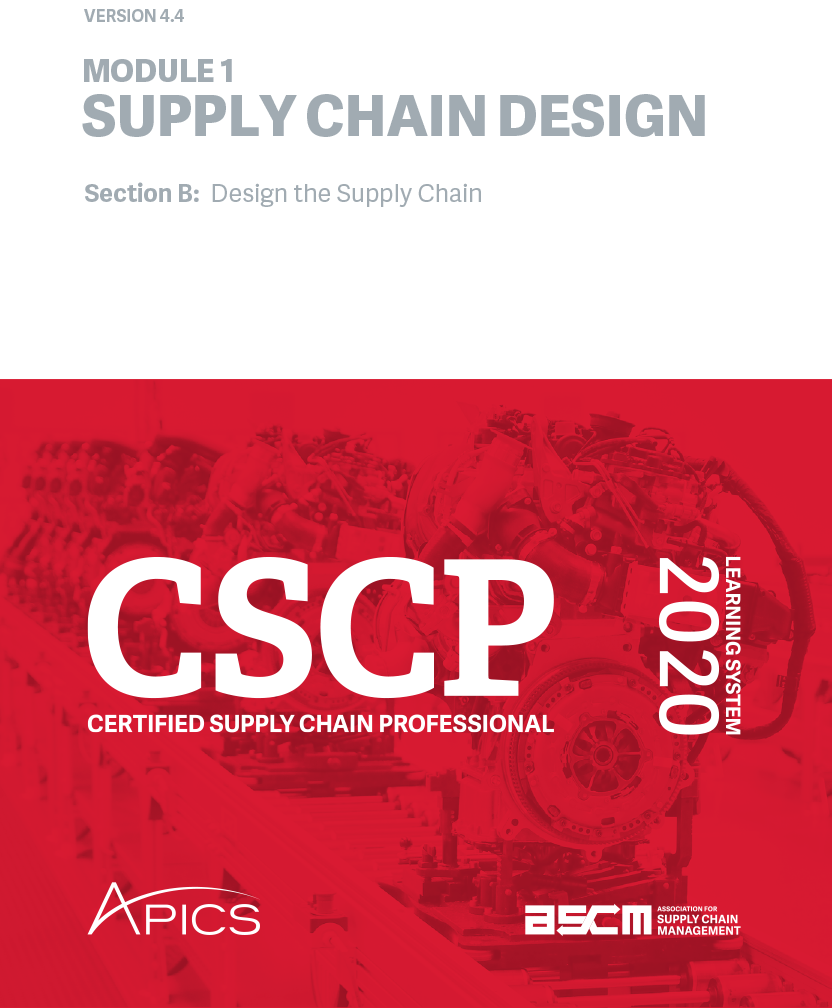
This section explores supply chain design by looking at the use of market research, financial modeling, and an understanding of product life cycle stages to develop a sense of customer and business requirements. Since the ideal is to design the product to meet strategic goals, various product design focus strategies are covered. Every good supply chain design also needs to address collaboration with supply chain partners as well as delivering value using supply chain information technology and the proper methods of acquiring and managing data. The section also covers primers on the fundamentals of communications and project management, which often need improvement to close the gaps between the as-is and the to-be states of a supply chain.
Once a supply chain has an approved strategy for enabling and complementing the organizational strategy, it is time to get to specifics. Network design is about specifying who, what, where, when, and why for every detail of a supply chain, not only the location and number of facilities but also how products will be designed to facilitate organizational strategy and how information systems will make the network transparent.
The key processes that supply chain managers need to be able to perform related to designing the supply chain are
Identifying customer and business requirements
Identifying the current and future states
Performing a gap analysis between the current and future states
Developing an action plan to close gaps.
The following is a general overview of these processes. The information required to plan and execute these processes is presented in this sections chapters.
The process of identifying customer and business requirements involves the following steps:
Researching organizational and supply chain strategy for customer and business requirements
Clarifying what degree of responsiveness and efficiency is required by stakeholders
Performing market research
Gathering information on customers product or service requirements
Developing an understanding of how customer and business requirements will change over the products life cycle
Understanding when customer and business requirements necessitate development of reverse or specialized supply chains
Determining when business requirements need to be satisfied through collaboration with supply chain partners
Determining business requirements for technology, data, and communication channels internally and between partners
The process of identifying the current and future states involves the following steps:
Collecting historical data for several periods up to the present on
Actual inventory levels per location and in transit
Inventory ordering methods and communications
Actual transit times and costs
Facility costs
Efficiency, responsiveness, and other metrics and key performance indicators
Technology usage, usefulness, and administrative costs
Mapping process flow for manufacturing and logistics for current products
Analyzing inventory trends and ordering methods
Modeling the supply chain in its as-is state using mathematical models, process flowcharts, and descriptive techniques
Developing a product or service design future state that will accommodate customer and business requirements and supply chain strategy
Using supply chain network optimization tools such as network modeling and operations research to design a supply chain that meets strategic goals including responsiveness and efficiency
Developing a technology model for desired information flows, analytic support, and electronic business
Communicating the product/service and supply chain designs to stakeholders and gathering feedback
Getting approval for the finalized designs
Documenting the finalized designs
The process of performing a gap analysis between the current and future states involves the following steps:
Comparing the as-is to the to-be state to determine needed changes to
Suppliers
Supplier contracts and expectations
Collaboration agreements and processes
Facilities (e.g., opened, closed, modified, relocated)
Product or service design
Production process flows and production lines
Processes, policies, and procedures that incorporate continuous improvement and other forms of responsiveness
Transportation modes or providers
Inventory policy and ordering methods
Technologies (adding or retiring)
Communications policies or procedures
Metrics to provide incentives to align with strategy
Estimating the scope of the changes and time and cost involved
Performing a feasibility study and financial analysis to determine the return on investment
Preparing a business plan and getting executive approval for it
The process of developing an action plan to close gaps involves the following steps:
Planning how to develop continuous improvement philosophies in ongoing operational processes, policies, and procedures
Planning how to communicate and manage change initially and over the long term
Developing project charters for all changes to be implemented as projects
Getting approval and funding for each project charter, including the authority to plan projects and expend funds
Planning each project to define the integration, scope, schedule, budget, quality, and how to manage human resources, communications, risks, procurements, and stakeholders
Planning the execution, monitoring and controlling, and closing process groups for each project
Note that implementing action plans involve the following steps:
Communicating and receiving feedback
Executing, monitoring and controlling, and closing projects using project management
Using change management to change the culture and ensure that project results become standard operating procedure
Change management is an important part of planning and implementing action plans but is addressed in a later section on continuous improvement.
This chapter is designed to
Describe the importance of understanding the marketplace as it relates to the supply chain
Discuss market research, demand generation, and the role of the four Ps of marketing in a customer-focused organization
Explain the factors used to select strategic partners
This chapter on business considerations addresses some of the tools used when identifying customer and business requirements.
At the end of the previous section, we looked at market research as a tool for strategic analysis. Here, we revisit the subject from supply chain design and product design perspectives. Financial modeling involves ensuring that solutions are likely to have a positive return on investment. Product research and modeling refers to determining how to adapt the supply chain to different stages of each products life cycle.
Font size:
Interval:
Bookmark:
Similar books «CSCP 2020 Module 1 Section B»
Look at similar books to CSCP 2020 Module 1 Section B. We have selected literature similar in name and meaning in the hope of providing readers with more options to find new, interesting, not yet read works.
Discussion, reviews of the book CSCP 2020 Module 1 Section B and just readers' own opinions. Leave your comments, write what you think about the work, its meaning or the main characters. Specify what exactly you liked and what you didn't like, and why you think so.

